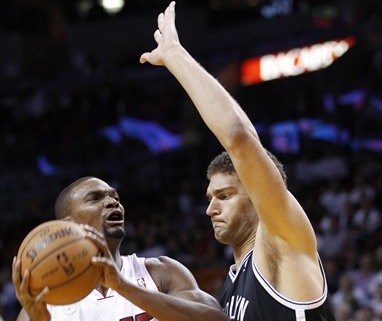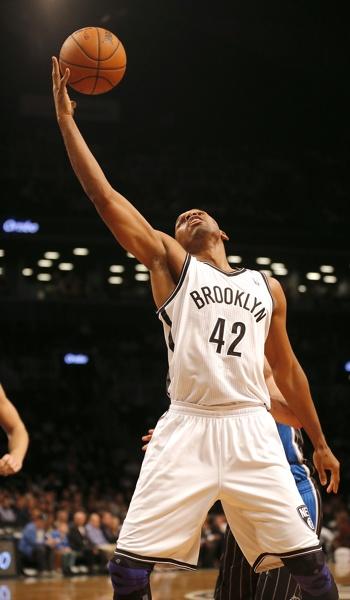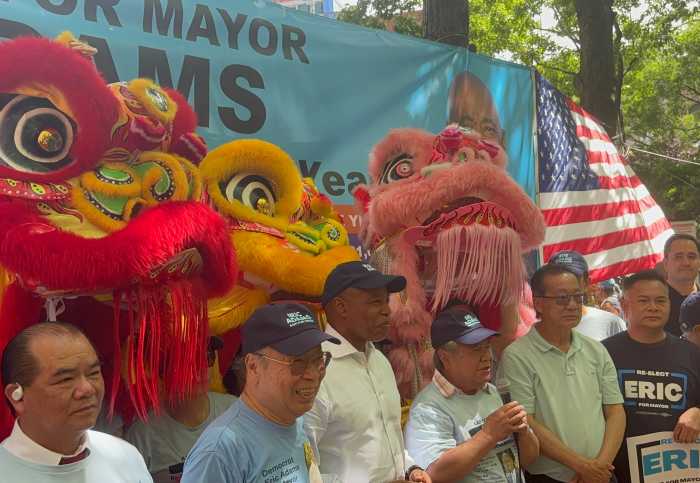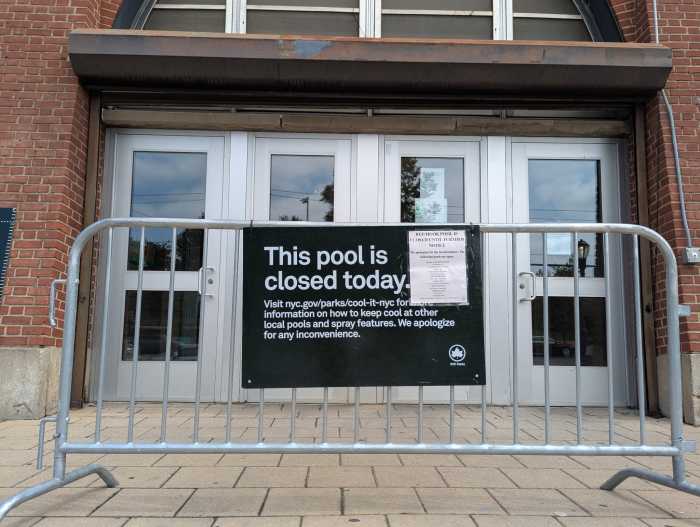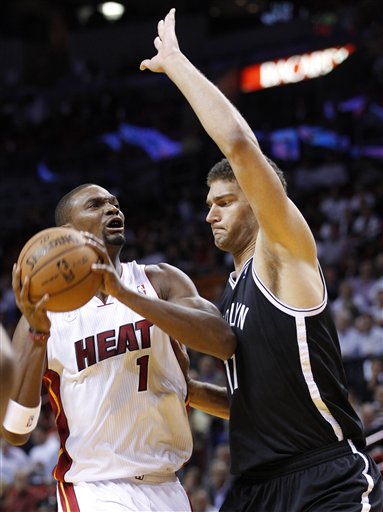 Miami Heat forward Chris Bosh receives an entry pass about fifteen feet from the basket on the left side of the floor. The Heat, up seven with plenty of time left in the game and on the shot clock, all stack up on the other side of the floor, giving Bosh all the space he needs to operate on his defender, Brooklyn Nets center Brook Lopez.
Miami Heat forward Chris Bosh receives an entry pass about fifteen feet from the basket on the left side of the floor. The Heat, up seven with plenty of time left in the game and on the shot clock, all stack up on the other side of the floor, giving Bosh all the space he needs to operate on his defender, Brooklyn Nets center Brook Lopez.
Bosh faces up on Lopez, a few feet parallel from the elbow, with nothing but Lopez between him and the basket. After about two seconds of reading the play, Bosh sees Lopez is “giving” the middle of the floor in his stance, and Bosh begins his move. Bosh takes two steps towards the basket, hoping to create enough space to get an open look at the basket.
Except he doesn’t. Lopez races alongside Bosh, keeping up with him to protect the basket, and Bosh ends up tossing a bad shot towards the rim.
As the game progressed, Bosh, along with Heat wings LeBron James and Dwyane Wade, continued to attack the basket — as they are wont to do — both with and without Lopez in the game. Wade & James were each even isolated on Lopez at different points throughout the game, and both tried to take advantage. Sometimes they did, but just as often, they ran into a wall. In the entire game, the Heat shot 12/23 from within eight feet on the Nets with Lopez on the floor — a good percentage if you’re looking at the whole floor, but well below the Heat’s season average from that range.
Here’s some examples of Lopez’s defense on that night, mostly near the rim:
Sweet freeze frame, bro.
At the Sloan Sports Analytics Conference this weekend, Grantland writer & visiting professor at Harvard University Kirk Goldsberry presented a research paper called The Dwight Effect: A New Ensemble of Interior Defense Analytics for the NBA which sought to answer a question by solving a problem: who is the best interior defender in the NBA, and what metrics would you use to answer that question?
Goldsberry’s study identifies two brands of dominant interior defense: basket protection and shot proximity. Because I don’t have the data that Goldsberry utilizes for shot proximity, I’m going to focus on an admittedly incomplete study of basket protection.
The best basket protectors have two major strengths. When opponents attack the basket, either out of the post or off the dribble, the best protectors are able to disrupt the shot enough to force a miss out of their opponents. Milwaukee Bucks forward Larry Sanders was Goldsberry’s poster child for this — when Sanders is close to the basket, opponents shoot just 38% from the field, well below the league average. (Conversely, with Golden State Warriors forward David Lee occupying that space, opponents shoot 63%.) So the first major strength is intuitive and direct — get in your opponent’s space and force him to alter his shot in a way that he can’t adjust to.
The second major strength is where “The Dwight Effect” comes in. Before Dwight Howard’s injuries made him less mobile, opponents were terrified of attacking Howard in the space close to the basket. His reputation and track record as a defensive monster acted as a psychological buffer between the basket and the ballhandler. His block percentage decreased, but the team’s defensive rating with him on the floor didn’t, because teams were avoiding the game’s best shots; according to Goldsberry’s study, the mere presence of Dwight Howard induces the highest amount of midrange shots in the league — the worst shots on the floor. Guys didn’t want to challenge him, lest he throw their shot and ego simultaneously into the second row.
Lopez doesn’t have this effect. There’s no psychological buffer between Lopez and opponents — his reputation as a poor defender precedes his performance, and players attack him because of it. This produces some odd results: Lopez has the highest block percentage of his career (blocking 5.5% of all shots on the floor), and that comes from a combination of basket protection factors: he’s both improved at disrupting opponent space while simultaneously dealing with a high number of attacks. With Lopez on the floor, 44.1% of opposing field goal attempts come from within eight feet (more than the league average of 42.5%), but teams only shoot 52.7% on those shots (beating the league average of 54.9%).
Averaging out those two factors — Lopez’s lack of a psychological buffer and his improved defensive disruption — leads to a funny conclusion. With Lopez on the floor, the Nets have given up 608 field goals from within eight feet. A league average center — one that allows field goal attempts within eight feet 42.5% of the time, and allows 54.9% shooting on those attempts — would have given up a grand total of… 608 field goals in the same time. Lopez’s averaged-out impact is, quite literally, perfectly average.
The above video of Lopez’s defense against the Heat bears this out. Along with his added strength, Lopez has learned how to use his length more effectively than in past seasons. Bad Lopez would often stand straight up-and-down, inviting guards to whirl around him. Though he still does that sometimes, more often than not you’ll see Lopez commit to a lower defensive stance, helping maximize his limited lateral quickness, and shoot upwards when he needs to contest a shot.
Even as his ability to turn players away solidifies, Lopez may not improve beyond a league average defensive impact. First impressions are often indelible, and it’s hard for me to imagine Lopez’s reputation as a “basket protector” changing over time, even as his defense has notably improved. Maybe it’s his comic books, or his comic voice, or his comic speed, but Lopez isn’t scary, and players go after the big man they think they can beat. All he can control is how he turns the shots away. In this season, he’s doing just that. So far, it’s evened out.
Statistical support for this story was provided by NBA.com.

